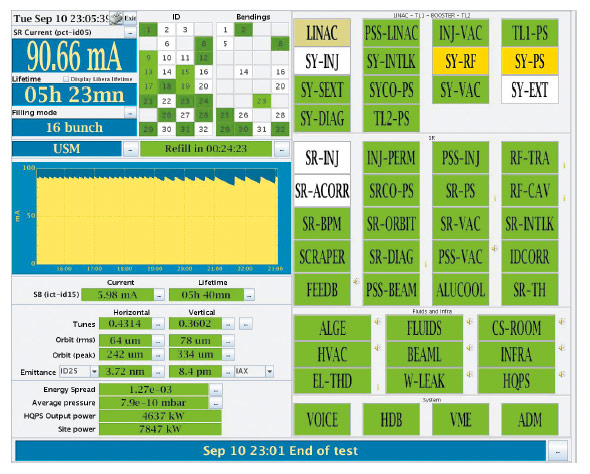Top-up operation
In order to reduce the heat load variation on the beamline optics, top-up filling of the storage ring is under evaluation. This mode of operation will be beneficial to the 16-bunch mode by reducing the current variation, but also by allowing delivery at low vertical emittance. Today, the vertical beam size is increased (blown-up) in order to increase the lifetime. For multibunch mode, in comparison to the smooth stability induced by the long lifetime, the frequent injection perturbations induced by the top-up have been evaluated in depth in collaboration with beamline scientists in order to establish the benefits, if any, for this filling pattern.
A new cleaning technique has been developed for this project and is now routinely used during user service mode (USM) for the 16-bunch and hybrid modes. It reduces the strong vertical blow-up just after injection from 2 nm to only a few pm. The development of bunch cleaning in the booster will continue and will benefit from the upgrade of the injector. In particular, a new booster power supply system (BPSS) operating at 4 Hz is under development for the dipole and quadrupole magnets of the booster.
Top-up in 16-bunch has been developed and tested during MDT. The reliability of the storage ring has been validated with 90 mA average current in 16-bunch, refilled every 10 minutes, lasting for hours without disturbance, all parameters being even more stable in this configuration. The radioprotection aspects are satisfactory (injection has already been performed with the front end open) but a formal agreement from the authorities for operation in USM is needed. Large horizontal stability perturbations are still induced during injection for a few seconds due to the presence of sextupoles in the injection bump – solutions using the feedback are under development. An injection sequencer has been developed in order to automatically manage the equipment and to optimise the electrical consumption. Using this tool, top-up injection is now completed in less than 30 seconds.
The injector upgrade has already been initiated with the renewal of the booster RF, which allows a drastic reduction in electrical consumption. In addition to the renewal of the BPSS, a number of parameters still remain to be finalised before implementation.
The top-up frequency is a crucial parameter for this project. A survey of the top-up operational aspects has been done for most light sources, showing large discrepancies between them. For the ESRF, the frequency will be determined following consultation with the users and could be between 10 and 30 minutes. Top-up tests with beamlines took place on Tuesday 10 September (see Figure 163) for 8 hours (2 hours with a refill every 10 minutes for preparation of the beamlines, then 2 hours with a refill every 10 minutes, 2 hours with a refill every 20 minutes and 2 hours with a refill every 30 minutes). Beam was delivered for 8 hours without any beam losses or major disturbances. Reports sent from each participating beamline are now being analysed. A preliminary result provided by ID18 indicates that a refill every 30 minutes is the extreme limit at which one can benefit from the stability of the optics.
 |
|
Fig. 163: Synopsis of eight hours of top-up tests in 16-bunch mode with beamlines. |
Beamlines ID13 and ID15, which use in-vacuum undulators that are normally incompatible with top-up injection, could be made to work in this new mode thanks to the inhibition of an interlock. Today during injection, the in-vacuum undulators are left slightly open, to avoid beam losses, but during top-up operation the in-vacuum undulators will need to remain closed. Normally an interlock prevents injection with a closed gap, but inhibiting this limitation allows the injection to take place with the gap closed. This produces higher beam losses at this location but preliminary results indicate that it is manageable.



